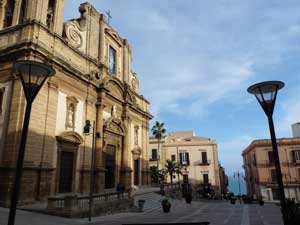Sciacca is a historic fishing port on the southern coast of Sicily. A workaday town rather than a polished tourist destination, it is known for its ceramics, its thermal baths and its religious festivals, as well as for its large fishing fleet. Sciacca’s location on the sea between the two Greek archaeological sites of Selinunte and Agrigento makes it a good stopover on a tour of the region, either for an short visit or an overnight stay. The name Sciacca is pronounced ‘shack-a’.
- Sicily destinations and practicalities: full menu (at foot of this page)
About Sciacca
Sciacca has ancient origins. There are thermal springs here, and around the seventh century BC the site became a thermal spa resort for the Greeks of ancient Selinunte, known as Thermae Selinuntinae. For Sicily’s Roman rulers the town was, as well as a spa, an important hub for their efficient mail service, and for the Arabs it was a trading port with North African connections. The town’s present name is probably Arab in origin. Sciacca continued to prosper and enjoyed a period of particular grandeur in the sixteenth century, when some fine buildings were constructed. Nowadays its main business is fishing.
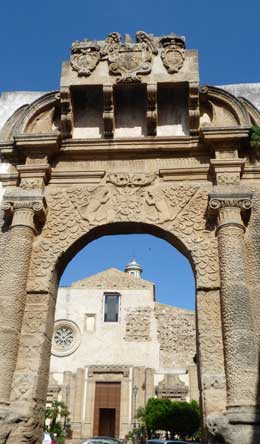
Present-day Sciacca spreads over different levels of the hillside. Down by the sea is the big fishing harbour, along with a few houses and seafood restaurants. The town’s main square, the panoramic Piazza Scandaliato, is on the next level up, with the heart of the historic centre spreading uphill behind it. Higher up the slope are the town’s castle and the upper perimeter of the old city walls. Beyond the old settlement lie sprawling and unattractive modern areas.
Sciacca isn’t a particularly touristy town, but there’s enough to fill a day’s sightseeing, especially if you take a trip out of the town to visit an eccentric attraction (more below). In the historic centre there is a good crop of interesting old churches and buildings, and it’s worth wandering around with a map admiring the architecture. Many buildings date to the sixteenth century; the grander ones in particular stand out among the humbler streets. Sciacca doesn’t put on airs for the tourist: it has a shabby atmosphere in places and although some buildings are well-cared-for, you will find others with a very poor and neglected appearance. This is an authentic and everyday Sicilian town, where ordinary people live and work.
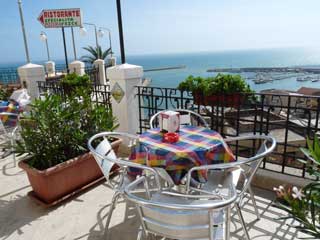
Sciacca’s prime feature is the panoramic piazza at its heart: Piazza Scandaliato. One side of this square opens onto a view of the fishing port and sea below. High-backed benches face either direction, so Sciacca’s old men and courting couples can choose to watch people passing by, or to face the view. This is a good place to begin an exploration of the town, as there is a tourist information office in the square. Either from your accommodation, or from this office, when open, you should be able to pick up some useful maps and tourist information in various languages: Sciacca may not be prettily-packaged as a tourist town yet, but it obviously is keen to encourage tourism.
There are only a handful of streets wide enough for cars in the centre of Sciacca, and these are frequently packed and chaotic with traffic. Pedestrians, though, are free to wander up and down the narrow lanes and alleys criss-crossing the centre. Some are wide enough for the town’s adventurous scooter-riders to glide down, others are narrow and have steps to climb. Visitors should note that touring Sciacca thoroughly, from sea-level to hill-top, is a strenuous endeavour with lots of climbing.
At a prominent high point on top of the hill is a large church dedicated to St. Michael, the traditional saint of high places. Following a steep lane downhill you reach the remains of Sciacca’s fourteenth-century castle, the Castello Luna, which is sometimes open to the public and hosts events in summer. Further downhill is a twelfth-century Norman chapel, the Chiesa di San Nicolò.The town’s Duomo, or Chiesa Madre, is situated in an attractive square just off Corso Vittorio Emanuele; the sea visible through a gap in the buildings opposite. Founded in the twelfth century, the church now has an elegant seventeenth-century façade which was never quite finished. One of the most curious buildings in town is Palazzo Steripinto, with its unusual studded stonework walls. The town’s fine old stone gateways are largely intact. Close to Piazza Scandaliato, visitors should spare a few moments for the former Church of Santa Margherita, with some lovely carvings on the exterior and an impressive interior. Just over the road is the Chiesa del Carmine, dating to the twelfth century, featuring a memorably off-centre rose window in its facade.
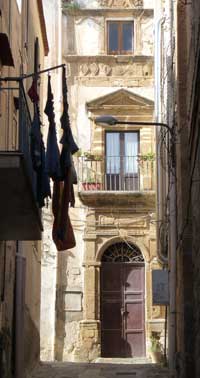
Sciacca still attracts visitors today for its thermal spas. At the Terme di Sciacca establishment a large range of treatments are available, many aimed at particular medical conditions and available as part of the Italian public healthcare system. The Stabilimento Termale is near the centre of town, on a panoramic clifftop road called Via delle Terme. There is also a thermal swimming pool complex outside town, called the Piscine Molinelli, and the adventurous tourist or spa enthusiast could find their way to the natural ‘steam caves’ in the slopes of Monte San Calogero (called the stufe di San Calogero), used since ancient times for therapeutic purposes and now another part of the Sciacca spa business.
Sciacca’s biggest industry is fishing and the town’s fishing harbour is large and functional rather than picturesque. Around 500 boats are based here. The port can be reached down a road or flights of steps from the main part of town, which is perched up above. Although it isn’t picture-postcard pretty, the harbour offers a chance to see a real working fishing industry, get views back towards the town, and to enjoy incredibly fresh seafood at one of the restaurants in this part of Sciacca.
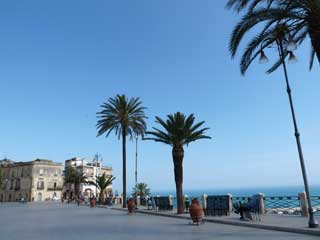
Sciacca is famous for its ceramic production, and along Corso Vittorio Emanuele there are several shops selling attractive, colourful majolica plates, tiles and more. If you have space in your luggage or are prepared to arrange postage these can make good souvenirs. I particularly liked the majolica illustrating the odd historical tale of Ferdinandea (Graham Island), a volcanic island which emerged from the sea nearby in 1831, was briefly claimed by the British among others, and then sank back beneath the waves five months later.
There are quite a few tempting restaurants around the historic centre, down little lanes. We ate a great and good-value evening meal at the Osteria Cappellino on Vicolo Cappellino, a cosy little trattoria where instead of a menu the owner reeled off today’s specialities, mostly seafood. There is also a panoramic restaurant alongside a cafe on Piazza Scandaliato, and more seafood restaurants down by the fishing port.
An eccentric garden
The most novel and interesting tourist attraction around Sciacca is the Castello Incantato (Enchanted Castle), an eccentric garden filled with naive artworks. The creator of this spectacle was Filippo Bentivegna (1888-1967), also known as ‘Filippo of the Heads’. A local man, he emigrated to America in the early twentieth century, and endured various difficulties and mishaps, including being beaten up by a love rival. Returning embittered to Sicily, he created a strange world of his own in this garden outside Sciacca, sculpting strange heads and figures thought to represent in some way his ‘enemies’. Bentivegna liked to be known as ‘His Excellency.’ The garden is open to the public (there’s an entrance charge) and visitors can explore the artist’s strange solitary world, from his sculptural heads to paintings within his home.
The Castello Incantato can be reached by driving east from town or by catching one of the local bus services. There’s a bus stop on Piazza Scandaliato; more information and timetables from the tourist information office. The garden closes on Mondays and for several hours over lunchtime.
Around Sciacca: Beaches and more sights
To explore the area immediately surrounding Sciacca, the local buses are of some assistance, but for comfortable touring you will really need to organise your own transport: a tour guide service or a hire car. There are sandy beaches along the coast to either side of the town. The hill town Caltabellotta (reachable using Lumia bus services) is strikingly-located around a rocky outcrop. Touring inland with a hire-car, you could visit Santa Margherita di Belice, the inspiration for the setting of the great Sicilian novel The Leopard, Menfi and the Planeta winery – Cantina Ulmo – near Sambuca di Sicilia – book ahead for tours and tastings.
Further afield, two of the greatest sights of this part of Sicily are the Greek ruins of Selinunte and Agrigento.
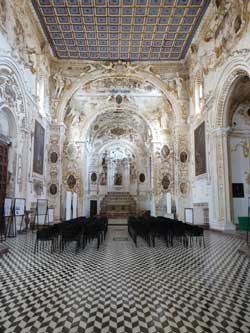
Events
Sciacca has a number of colourful festivals throughout the year. Its pre-Lent Carnival (Carnevale) is renowned for the scale of the town’s celebrations, with large festival floats paraded through the streets. At the beginning of February and again at Ferragosto (August 15th; the festival of the Assumption) a heavy statue of the Madonna is carried through town by scores of barefoot fishermen, in a re-enactment of a miraculous event in 1626 when during a pilgrimage procession, there was lightning, smoke arose from the statue, and Sciacca was saved from the Plague. Another good festival to watch is the fishermen’s big June celebration of St. Peter (San Pietro), with processions and events down by the harbour including a contest where young men scramble to reach the end of a slippery pole without sliding into the sea.
Sciacca travel and transport
Sciacca doesn’t have a railway station (there is a railway line, abandoned), but it is connected to the rest of Sicily by buses. A company called Lumia run buses westwards to Trapani via Castelvetrano, Marsala and Trapani Airport, and eastwards to Agrigento. There’s also a direct bus service to Palermo operated by Autolinee Gallo; it runs irregularly throughout the day and takes around an hour and forty minutes. Occasional Gallo services also connect Sciacca with Palermo Airport. There is a railway station in Castelvetrano on the Lumia bus route where travellers can change to a local bus to Selinunte, or connect with trains going to Palermo or to Trapani.
In Sciacca, long-distance buses generally stop alongside a little park called the Villa Comunale, a short walk from Piazza Scandaliato. You can buy Lumia tickets on the day of travel from Bar Giglio over the street, or from the bus driver. Check the bus timetable carefully, especially if you are relying on one of the scarce services on a Sunday or public holiday – at the time of writing the Agrigento bus on a public holiday departs from an obscure petrol station forecourt just outside town: our B&B owner arranged a taxi to take us to this stop.
Car drivers should be prepared for confusing, narrow and busy streets in Sciacca; it’s not a particularly easy town to drive into. There is car parking just outside Porta Palermo, a gateway in the north-west of the town wall, and also in Piazza Rossi, in the centre near Piazza Scandaliato.
Sciacca accommodation
Hotels and B&Bs
I stayed at the practical, comfortable B&B Garibaldi Relais, which is in a convenient location just off the main panoramic piazza. Other options include Locanda del Castello, a very comfortable B&B in a historic building in the upper part of town.
> Find accommodation in and around Sciacca
Verdura Resort
For something very different, the five-star Verdura Golf & Spa Resort is a luxury modern resort several miles along the coast from Sciacca with on-site activities including tennis and golf, a large swimming pool, countryside jogging trails, a beach, children’s facilities and spa treatments. This might be a particularly good place to splash out on a couple of days of relaxation during a busy touring itinerary, or to enjoy a leisurely family holiday.
Highlights
Combine Sciacca with
Useful external links
Terme di Sciacca – thermal spa
Autolinee Gallo – Sciacca-Palermo buses
